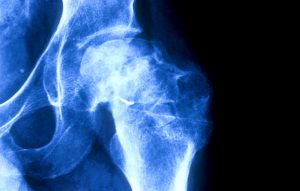Young Dancer Returns to the Stage After AVN Treatment
 Searching for options to allow him to keep his hip after a diagnosis of avascular necrosis (AVN), a 20-year-old male dancer consulted with Duke orthopaedic surgeon David Ruch, MD. The patient understood that if the AVN was left untreated, the bone could become fragile and collapse, resulting in debilitating osteoarthritis. As a highly tuned athlete looking forward to a career in theater and dance, the condition could have easily ended his dreams.
Searching for options to allow him to keep his hip after a diagnosis of avascular necrosis (AVN), a 20-year-old male dancer consulted with Duke orthopaedic surgeon David Ruch, MD. The patient understood that if the AVN was left untreated, the bone could become fragile and collapse, resulting in debilitating osteoarthritis. As a highly tuned athlete looking forward to a career in theater and dance, the condition could have easily ended his dreams.
AVN of the hip is fairly unusual in young people, and treatment options can be limited for those who want to retain an active lifestyle. “When this condition occurs in someone older, we might consider an artificial hip, but in this young, active dancer, that was not the ideal approach,” says Ruch.
Question: What approach was taken to preserve the patient’s native hip joint?
Answer: Ruch performed a free vascularized fibular grafting (FVFG) procedure, using a segment of the bone from the fibula, along with its blood vessels, to reconstruct the diseased joint. By replacing the necrotic bone with a vascularized graft, the area was able to heal, thus preventing the development of arthritis.
James Urbaniak, MD, Virginia Flowers Baker Professor and Chief Emeritus of Orthopaedic Surgery at Duke, pioneered FVFG in the late 1970s. In his early studies, Urbaniak noted that FVFG was particularly effective in young people because an artificial hip may need to be replaced during a patient’s lifetime, and the more active a patient is, the faster the artificial hip wears out.
Today, Duke orthopaedic surgeons perform approximately 50 such procedures per year, which has allowed them to continue perfecting it and follow patients postoperatively to study long-term results. “We’ve found that this procedure is able to prevent the need for a total hip replacement in the vast majority of our younger patients, particularly those who have had chemotherapy or steroids to treat chronic diseases or cancer,” Ruch says.
The patient underwent an intensive physical therapy program postoperatively, using crutches for several months and gradually resuming weight-bearing activities as the new hip joint healed. “He did beautifully with it,” Ruch recalls. “Many patients need a lot of encouragement postop, but he has incredible strength of spirit and needed no encouragement. As a result, he was back to dancing very quickly.”
Watch the patient perform a dance routine 2 years after the FVFG procedure.
Courtesy of patient’s family.